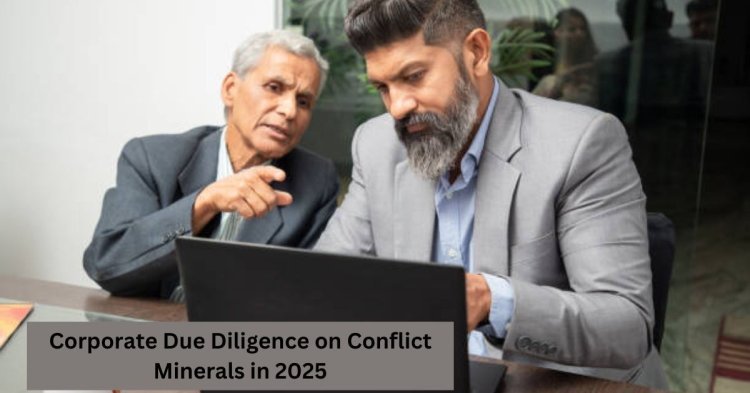Corporate Due Diligence on Conflict Minerals in 2025
Ensure ethical sourcing with corporate due diligence on conflict minerals in 2025. Stay compliant with evolving regulations and responsible supply chain practices.

Introduction
In 2025, corporate due diligence on conflict minerals continues to be a crucial aspect of responsible supply chain management. With increasing regulatory scrutiny and evolving global standards, businesses operating in the USA must ensure compliance with conflict mineral regulations. Ethical sourcing, transparency, and risk assessment are integral to maintaining sustainability and legal adherence. This explores the latest trends, regulatory updates, and best practices for conflict mineral compliance while ensuring responsible business operations.
Understanding Conflict Minerals and Their Impact
Conflict minerals typically refer to tin, tungsten, tantalum, and gold (3TG), which are often sourced from regions associated with human rights violations and armed conflicts. The extraction and trade of these minerals have been linked to unethical labor practices, environmental degradation, and funding of armed groups.
Due diligence in conflict mineral compliance aims to prevent companies from inadvertently supporting such activities. Organizations must trace their supply chains, assess risks, and implement responsible sourcing policies to meet legal and ethical standards.
Key Regulations Governing Conflict Mineral Compliance
1. Dodd-Frank Act, Section 1502
The Dodd-Frank Wall Street Reform and Consumer Protection Act mandates that publicly traded companies in the USA disclose their use of conflict minerals if they are necessary for the functionality of their products. This rule requires organizations to conduct due diligence and submit an annual report to the Securities and Exchange Commission (SEC).
2. OECD Due Diligence Guidance
The Organization for Economic Co-operation and Development (OECD) provides a globally recognized framework for responsible mineral sourcing. It outlines a five-step due diligence process to help companies identify risks and implement corrective actions.
3. EU Conflict Minerals Regulation
Although it primarily affects businesses operating in the European Union, the EU Conflict Minerals Regulation influences global supply chains. Many US-based companies align with these standards to maintain international trade relationships and ensure responsible sourcing.
4. Evolving ESG and Sustainability Reporting
In 2025, Environmental, Social, and Governance (ESG) reporting has gained prominence. Companies integrating conflict minerals into their ESG frameworks demonstrate corporate responsibility, attracting ethical investors and customers.
Best Practices for Corporate Due Diligence on Conflict Minerals
1. Conducting Supply Chain Risk Assessments
Organizations must thoroughly analyze their supply chains to identify potential risks related to conflict minerals. This involves working closely with suppliers to ensure transparency and responsible sourcing practices.
2. Implementing a Robust Due Diligence Process
A comprehensive due diligence framework should align with OECD guidelines and include:
- Establishing strong company policies on conflict mineral compliance.
- Engaging with suppliers to collect sourcing information.
- Conducting third-party audits to verify supplier claims.
- Reporting findings through transparent disclosures.
3. Leveraging Technology for Traceability
Advanced technologies such as blockchain, AI-driven analytics, and automated tracking systems are transforming conflict minerals compliance. These tools help businesses enhance transparency, trace mineral origins, and ensure supplier accountability.
4. Supplier Training and Ethical Sourcing Initiatives
Educating suppliers on ethical sourcing practices improves compliance across the supply chain. Businesses should implement training programs and collaborate with industry stakeholders to promote responsible mineral sourcing.
5. Enhancing Stakeholder Engagement
Companies must engage with industry associations, regulatory bodies, and non-governmental organizations (NGOs) to stay informed about regulatory changes and emerging best practices. Effective communication with consumers also builds trust and reinforces corporate responsibility efforts.
Challenges in Conflict Mineral Compliance
1. Complex Global Supply Chains
Tracking the origin of minerals across multi-tiered supply chains remains a challenge for businesses. Many companies rely on indirect suppliers, making it difficult to verify sourcing practices.
2. Evolving Regulatory Landscape
Regulations concerning conflict minerals continue to evolve. Companies must stay updated on new legal requirements and adjust their due diligence processes accordingly.
3. Cost and Resource Allocation
Conducting thorough due diligence requires financial investment and dedicated resources. Small and medium-sized enterprises (SMEs) may face difficulties implementing comprehensive compliance programs.
4. Supplier Resistance and Data Inconsistencies
Some suppliers may resist providing transparency due to confidentiality concerns or lack of proper documentation. Businesses need effective strategies to address these challenges while ensuring compliance.
Future Trends in Conflict Mineral Compliance (2025 and Beyond)
1. Increased Focus on ESG Integration
Conflict mineral is becoming a critical component of ESG frameworks. Investors and regulatory bodies are emphasizing responsible sourcing as part of broader sustainability initiatives.
2. Greater Adoption of Blockchain for Traceability
Blockchain technology is expected to play a larger role in verifying supply chain authenticity. More companies are implementing blockchain solutions to ensure conflict-free mineral sourcing.
3. Stricter Reporting Requirements
With growing concerns over ethical supply chains, regulatory agencies are likely to introduce stricter reporting mandates. Businesses must prepare for enhanced disclosure obligations and compliance audits.
4. AI and Automation in Compliance Processes
Artificial intelligence (AI) and machine learning are increasingly being used to streamline compliance efforts. These technologies help companies analyze vast amounts of supply chain data, identify risks, and enhance due diligence processes.
Conclusion
As conflict minerals continue to evolve in 2025, businesses must adopt proactive due diligence strategies to ensure responsible sourcing. Compliance with regulations such as the Dodd-Frank Act and adherence to OECD guidelines are essential to maintaining ethical supply chains.
By leveraging technology, conducting risk assessments, and engaging with stakeholders, organizations can enhance transparency and meet compliance standards. Ensuring conflict mineral compliance not only mitigates legal risks but also strengthens corporate reputation and promotes sustainability in global supply chains.
Staying ahead of industry trends and regulatory changes will be crucial for companies aiming to maintain ethical business practices in an increasingly scrutinized market environment.
What's Your Reaction?













